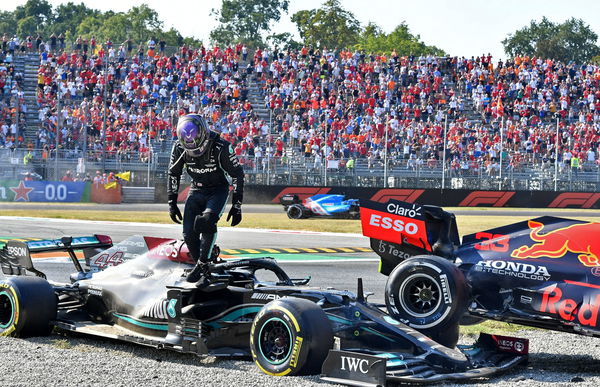
via Reuters
Formula One F1 – Italian Grand Prix – Autodromo Nazionale Monza, Monza, Italy – September 12, 2021 Mercedes’ Lewis Hamilton after crashing out of the race with Red Bull’s Max Verstappen REUTERS/Jennifer Lorenzini TPX IMAGES OF THE DAY

via Reuters
Formula One F1 – Italian Grand Prix – Autodromo Nazionale Monza, Monza, Italy – September 12, 2021 Mercedes’ Lewis Hamilton after crashing out of the race with Red Bull’s Max Verstappen REUTERS/Jennifer Lorenzini TPX IMAGES OF THE DAY
The FIA is a governing body controlling the interests of most motorsports across the world, most famously the F1. The governing body has multiple rules and regulations in place to make the sport safe and streamlined. And each year the FIA attempts to make motorsports safer. This endeavor, to make racing safer, some would argue, started late, especially after the sport lost some of its finest to racing accidents. However, to the FIA’s credit, the sport and especially the cars have become a lot safer over the years.
ADVERTISEMENT
Article continues below this ad
One of the most noticeable and prominent safety addition to the Formula single-seaters in recent years is the Halo, which was initially introduced in 2018. The Formula community widely opposed the Halo, initially, for its aesthetics. However, the safety aspect overpowered the orthodox philosophies, and the Halo became a standard throughout the Formula racing series.
Read More: About Cockpits in F1 Including Dimensions, Halo & Others
Since then, Halo has really proved its worth, saving countless lives which would’ve been at significant risk without it. The latest example in F1 is from the 2021 season’s Italian Grand Prix, where Max Verstappen’s RB16B sat atop Lewis Hamilton’s W12.

via Reuters
Formula One F1 – Italian Grand Prix – Autodromo Nazionale Monza, Monza, Italy – September 12, 2021 Red Bull’s Max Verstappen and Mercedes’ Lewis Hamilton crash out of the race REUTERS/Jennifer Lorenzini TPX IMAGES OF THE DAY
The Mercedes man, well aware of the consequences that could have taken place without the Halo, said, “Thank god for the halo. That ultimately saved me. And saved my neck.”
And another halo-centered incident comes to play at the British GP in F2.
F1, F2, and F3 cars are safer with the halo
The incident involving Roy Nissany of DAMS and Dennis Hauger of Prema Racing again showed the importance of the halo. Hauger went airborne, going over some sausage kerbs, and hit Nissany’s single-seater in the second lap of the British GP. Luckily, none of them sustained serious injuries, which might not have been the case without the halo.
SAFETY CAR (LAP 2/29)
Nissany and Hauger make contact, with Hauger going airborne over the kerb
Thankfully both drivers are out of their cars under their own power#BritishGP #F2 pic.twitter.com/pQV18EHTgT
— Formula 2 (@Formula2) July 3, 2022
Roy #Nissany is a lucky lucky boy!!!!#F2 #SilverstoneGP pic.twitter.com/SL9zsV8FAr
— McLaren Fan ⭐️⭐️ (@ColeTrickle515) July 3, 2022
Nissany unquestionably the architect of it all with some very poor driving, Hauger an innocent passenger in that horrible accident. Halo proving its value once again, sausage kerbs proving their danger once again.
— Will Buxton (@wbuxtonofficial) July 3, 2022
Wow, I’m so thankful for the halos and the safety they have brought to this sport #F2 #Halo #FIA
— Abbi Pulling (@AbbiPulling) July 3, 2022
A few users, including Will Buxton, pointed out the dangerous sausage kerb, a rare but not a nonexistent dangerous element on tracks.
Two things need to be reviewed from that incident:
The existence of sausage kerbs on race tracks, and Roy Nissany's place on the F2 grid. That incident was completely avoidable.#F2 #BritishGP
— Josh Revell (@joshrevellyt) July 3, 2022
Roy Nissany really is not good enough to be in Formula 2. Shocking driving – and very fortunate to be saved by the halo there. #BritishGP
— Phillip Horton (@PHortonF1) July 3, 2022
Halo saved Roy Nissany's life. That's an accident he was entirely to blame for. The kerb launched Hauger's car into him but equally it's not designed to be hit from that angle because cars shouldn't be forced off the road like that into a braking zone. Race ban merited, I think.
— Scott Mitchell (@SMitchellF1) July 3, 2022
ADVERTISEMENT
Article continues below this ad
A host of users pointed out Nissay’s involvement in being the catalyst of the incident, but it is not lost on any user how the halo saved his life.
ADVERTISEMENT
Article continues below this ad
Watch This Story: 2021 Rivals Lewis Hamilton Max Verstappen Giggle Over F1 Struggles In Wholesome Moment
A lot of the blame is also going to sausage kerbs which are highly dangerous and often damage the floor of the car. However, the credit goes to the halo for avoiding yet another fatal accident in Formula racing.
ADVERTISEMENT
ADVERTISEMENT
ADVERTISEMENT
ADVERTISEMENT

